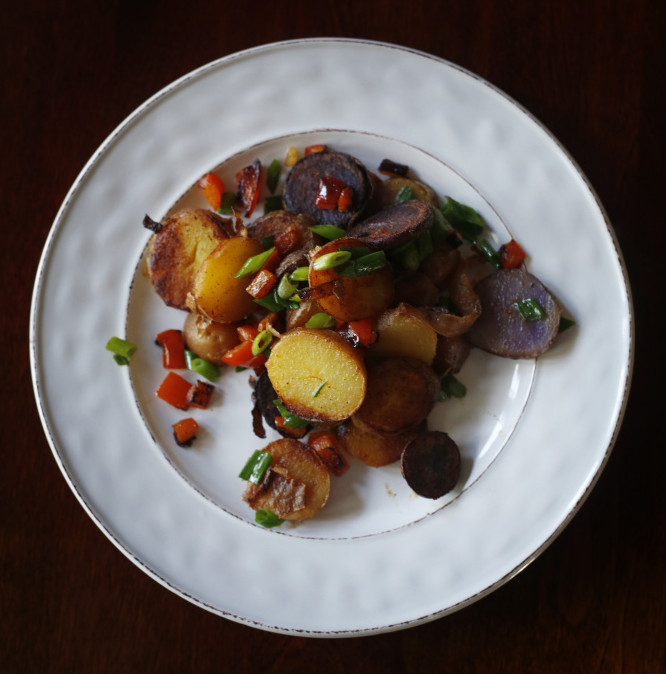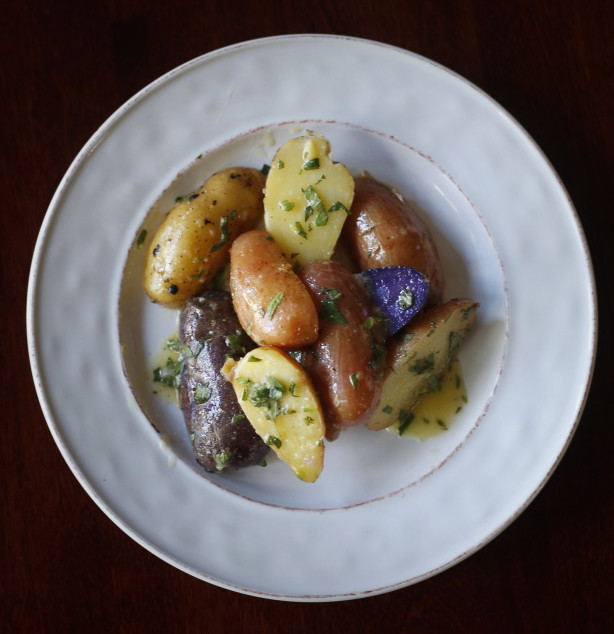Last summer my friend Sarah was weeding out her mother’s cookbook collection and set aside for me a lovely little hardback from 1960 called “The I Hate to Cook Book” by Peg Bracken. It’s got recipes for things like “Something Else to Do with New Potatoes Besides Boiling Them and Rolling Them in Melted Butter and Parsley” and quirky illustrations of perfectly coiffed but scowling women pulling off culinary shortcuts to minimize their time behind the stove.
Sarah passed this book along to help me better understand that not everyone enjoys being in the kitchen as much as I do. On page 29, Bracken scornfully assesses how “home ec-sperts who made straight A’s in advanced cream sauce” changed the reputation of loathly leftovers to be celebrated “plan-overs.”
With a plan-over, you intentionally prepare extra food the first time it’s cooked and creatively use portions of it several times in several guises throughout the week. The idea is you actually want to eat plan-overs instead of merely feeling obligated to consume the leftovers before they go to waste.
Bracken says the name change does not alter leftovers’ palatability. But I’d argue that plan-overs are key to making locally sourced foods – whether they arrive in your kitchen in a CSA box or a reusable farmers market bag or a basket from your garden – a more plausible staple in your kitchen.
Thanksgiving turkey is the pinnacle of plan-overs. When the 19 people in my immediate family on the Burns side gather, the bird we buy is never meant to last just one meal. We plan accordingly – typically roasting a 20-pounder and a couple of extra breasts – so there is enough meat planned-over to make sandwiches to fuel our respective rides back down the Massachusetts Turnpike.
There is no good reason we can’t take the same tactic with Thanksgiving sides. Take local fingerlings, which are particularly fetching at this time of year. Here’s how it works: Buy 3/4 of a pound for each person you have to feed. That allows for a 1/4-pound portion for each person for three meals running.
All the potatoes get boiled together to start. One-third is tossed with a vinaigrette that mimics the flavors of your roasted turkey, another third is sliced and pan fried with green onions for Friday’s breakfast, and the remaining third is flattened and oven fried in olive oil for dinner on Saturday (see progressive recipe).
If your family sits in the mashed potatoes camp, plan on closer to 1 pound of local russet potatoes per person to allow for peeling. Boil and mash them as you normally would, but remove 2/3 from the pot before stirring in milk and butter.
Make a hearty soup for Friday’s dinner by frying bacon and softening onion and mushrooms in its grease, and adding equal parts mashed potatoes, broth and a few seasonings of your choice. Mix the last of the plan-over mashed potatoes with shredded cheddar cheese and an egg for mashed potato muffins for breakfast on Sunday.
In the end, you’ll count plan-overs among the things for which you are thankful.
PLAN-OVER FINGERLING POTATOES
The Irish side of me always wants potatoes on the plate. Here is a recipe – or three, really – for how I will serve them this week so none of the beautiful fingerlings I buy locally get wasted. For the first meal, we eat them dressed in a lemon vinaigrette, for the second meal smashed and oven-crisped with rosemary olive oil, and for the third sliced and sautéed with scallions.
Serves 4, three times over
3 pounds fingerling potatoes, scrubbed
1/3 cup apple cider vinegar
1/3 cup kosher salt, plus more for seasoning
Zest of 1 lemon and 3 tablespoons juice
2 small garlic cloves
1 teaspoon Dijon mustard
1 teaspoon white wine vinegar
1 cup olive oil
Black pepper
2 teaspoons of chopped fresh cilantro, basil or marjoram (or a mix)
1 sprig rosemary
1 red bell pepper, diced
1/2 teaspoon chipotle chili powder
6 scallions, green parts only, sliced thinly on a diagonal
Combine potatoes, cider vinegar, salt and 1½ gallons of water in a large pot. Place the pot on medium high heat until the water begins to boil, reduce the heat to medium low and simmer until potatoes are tender at the center. The timing will depend on the size of the potatoes; check for tenderness with the tip of a knife.
When they are tender, drain the potatoes and let them sit in the colander for 10 minutes until they are cool enough to handle. Slice 1/3 of the potatoes in half lengthwise and place them in a large bowl.
Combine the lemon zest and juice, 1 garlic clove, mustard, white wine vinegar and 1/2 cup olive oil in a blender until the vinaigrette is emulsified.
Pour over warm potatoes and toss. Sprinkle with chopped herbs and serve warm.
Spread out the remaining 2/3 of the potatoes on a baking sheet to cool completely. Refrigerate.
Fingerling Plan-Over 1: Bring half of the remaining potatoes to room temperature. Use a small saucepan to heat 1/3 cup olive oil, 1 garlic clove and rosemary sprig. When the oil simmers slightly, remove it from the heat and let sit for 15 minutes. Preheat the oven to 425 degrees F. Line a baking sheet with foil. Spread the potatoes on the pan. Use a flat-bottom coffee cup to help smoosh each potato so the skin cracks and the potato flattens to about 1/2-inch. Pour the flavored oil over the potatoes. Sprinkle liberally with salt and black pepper. Bake until crispy (about 25-30 minutes).
Fingerling Plan-Over 2: Slice the remaining fingerlings into 1/4-inch coins. Heat 2 tablespoons olive oil in a large skillet over medium high heat. Add the red peppers and sauté for 3 minutes. Add chili powder and potatoes and sauté, stirring frequently, until the potatoes start to brown (10-12 minutes). Remove from heat, toss potatoes with scallions. Serve warm.
Christine Burns Rudalevigs is a food writer, recipe developer and tester, and cooking teacher in Brunswick. She writes about feeding her family Maine seafood at familyfish.net. Contact her at cburns1227@gmail.com.
Send questions/comments to the editors.




